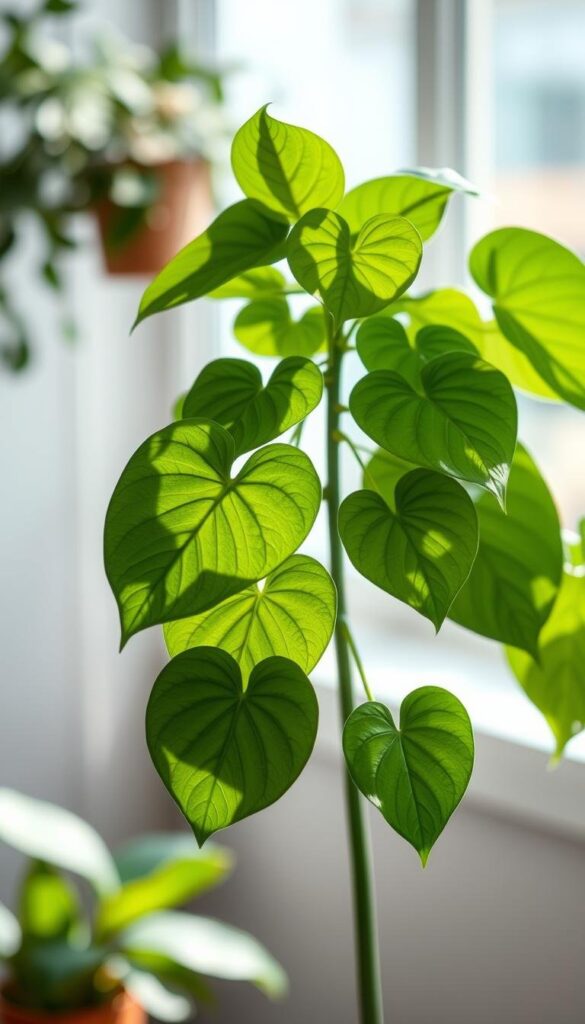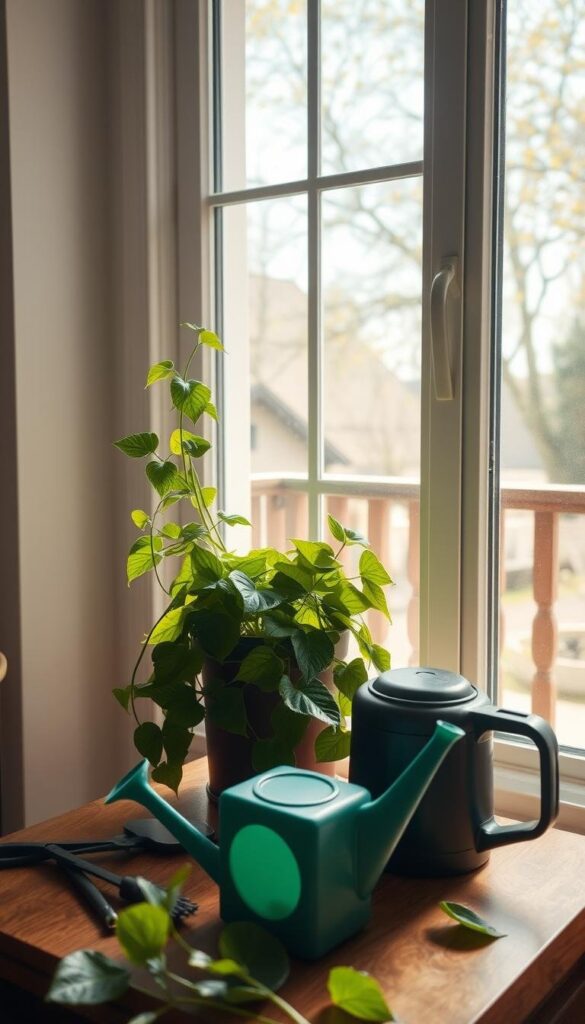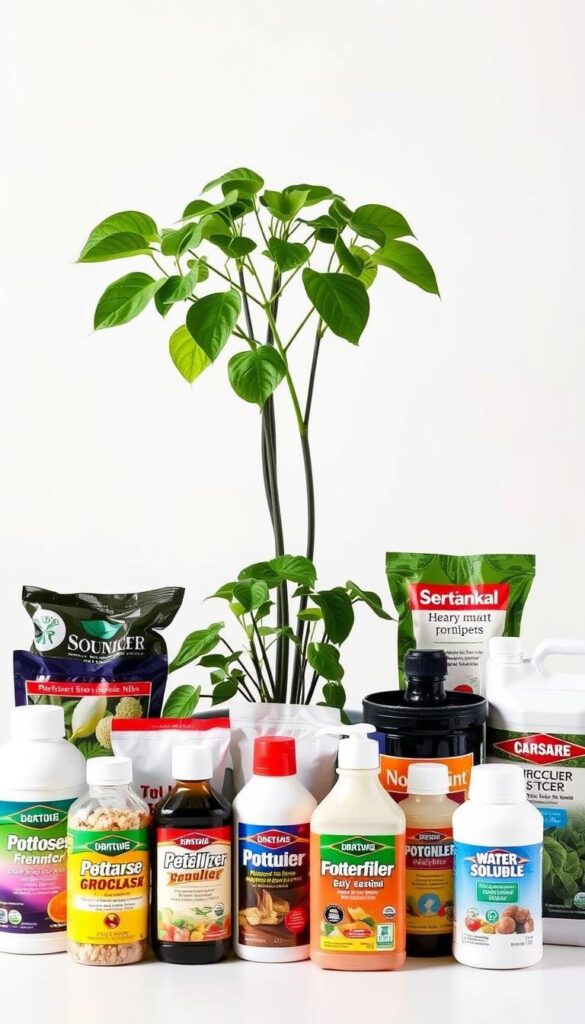This post may contain affiliate links. If you click and buy, we may earn a small commission at no extra cost to you. Learn more.
I’ve always loved plants, and the Pothos is one of the most forgiving. It’s perfect for busy people because it’s easy to care for. Its heart-shaped leaves and vines add beauty to any room.
Whether you’re new to gardening or have years of experience, Pothos is a great choice. It brings life to your home without being too demanding.
After years of caring for Pothos plants, I’ve learned what they need to thrive. The right amount of water, light, and care make all the difference. This guide will cover everything from light needs to pest prevention. Your Pothos will stay lush and vibrant with the right attention.
Contents
- 1 Understanding Pothos: An Introduction
- 2 Essential Care Tips for Healthy Pothos
- 3 Light Requirements for Optimal Growth
- 4 Feeding Your Pothos: Nutritional Needs
- 5 Pruning Pothos for Healthy Growth
- 6 Common Pests and Diseases in Pothos
- 7 Pothos Propagation: How to Grow New Plants
- 8 Troubleshooting Pothos Issues
- 9 Seasonal Care for Pothos Plants
- 10 Choosing the Right Pot for Your Pothos
- 11 Benefits of Having Pothos in Your Home
- 12 Frequently Asked Questions About Pothos
- 13 FAQ
- 13.1 How Often Should I Water My Pothos?
- 13.2 Can Pothos Survive in Low Light?
- 13.3 What Should I Do if My Pothos is Overwatered?
- 13.4 What is the Best Soil for Pothos?
- 13.5 How Do I Recognize Pests on My Pothos?
- 13.6 Is Pruning Necessary for Pothos?
- 13.7 Can I Propagate My Pothos Easily?
- 13.8 Do Pothos Plants Produce Flowers?
Understanding Pothos: An Introduction
Epipremnum aureum, or Pothos, comes from Southeast Asia’s rainforests. It’s also known as Devil’s Ivy. This plant loves indoor spaces, making it perfect for both new and experienced plant lovers. Let’s dive into what makes it so unique.

What is Pothos?
Pothos grows by climbing or hanging down. It has heart-shaped leaves that can be bright green or have cool patterns. Being an Epipremnum aureum, it belongs to the Araceae family. It’s nicknamed Devil’s Ivy because it can handle low light and even forgetfulness.
Different Varieties of Pothos
- Golden Pothos: Bright yellow-gold streaks on heart-shaped leaves.
- Marble Queen: Cream and green marbled patterns with slower growth.
- Neon Pothos: Intense lime-green foliage that prefers indirect light.
Common Names and Recognition
It’s called Devil’s Ivy because it’s so tough. In some places, it’s known as Money Plant. You can spot Pothos by its shiny leaves and long stems. It fits well in hanging baskets or on trellises, making it easy to place anywhere.
Essential Care Tips for Healthy Pothos
Every Pothos owner knows this houseplant thrives with proper care. Let’s break down the basics to keep your plant lush and green.

Watering Frequency and Techniques
I’ve learned that overwatering is a common pitfall. Here’s my method:
- Check soil moisture by sticking a finger 1–2 inches deep. Water only when dry.
- Drain excess water after watering to prevent root rot.
- Yellow leaves? That’s a sign to adjust your watering routine.
Ideal Soil Types for Pothos
Good soil makes all the difference. My go-to mix includes:
- Well-draining potting mix with perlite or orchid bark.
- Avoid heavy soils like pure peat moss—they retain too much moisture.
I use a pre-mixed aroid blend, as Pothos belongs to the aroid family.
Importance of Humidity Levels
This houseplant adapts to most homes, but humidity tips can boost its health. Try these:
Simple ways to add humidity:
- Mist leaves weekly in dry climates.
- Place a pebble tray with water under the pot.
- Group with other plants to create a microclimate.
By following these steps, your Pothos will reward you with vibrant growth. Small adjustments make a big difference for this resilient houseplant.
Light Requirements for Optimal Growth
Pothos is known for being a low light plant. But it really thrives with the right amount of light. It does well in dim spots, but indirect sunlight helps it grow faster and stronger. Let’s explore what it needs.

Best Lighting Conditions
Pothos loves being near east or north-facing windows. The morning light there is perfect for growth without burning the leaves. For south or west windows, keep the plant 3–5 feet away or use curtains to filter the light. Also, rotate the pot every month to help it grow evenly.
- Indirect light (like filtered through blinds) keeps variegation bright.
- Avoid direct noon sun—leaves bleach or scorch easily.
- Low light environments (e.g., office desks) are okay, but growth is slower.
Signs of Too Much or Too Little Light
Look out for these signs:
- Too little light: Stems stretch long between leaves (leggy growth), smaller new leaves, or faded variegation.
- Too much light: Brown, crispy edges or white spots on leaves (sunburn).
If you notice problems, move it slowly to a better spot. The right place means your pothos will grow lush and healthy without stress.
Feeding Your Pothos: Nutritional Needs
Nutrition is key for a healthy indoor plant. Pothos can do well with little care, but the right food makes it grow lush and green. Learn how to pick the best nutrients and avoid too much.

Recommended Fertilizers for Pothos
Pothos does well with balanced fertilizers. Look for NPK ratios like 10-10-10 or 20-20-20. Here’s a quick guide:
| Type | Benefits | Examples |
|---|---|---|
| Liquid | Quick absorption; easy to mix | Miracle-Gro, diluted weekly |
| Slow-release | Long-lasting nutrition | Osmocote Plus, applied every 3 months |
| Organic | Soil-friendly nutrients | Worm castings, fish emulsion |
Frequency of Fertilization
Feed your indoor plant when it’s growing fast (spring/summer). Don’t feed as much in fall/winter. Too much can hurt the roots—watch for brown tips. Here’s a simple plan:
- Spring/Summer: Fertilize every 4-6 weeks
- Fall/Winter: Skip or use half-strength
“Pothos prefers light feeding—less is more. Stick to a routine to avoid stress.” – Plant Expert Guide
Always water the soil first to prevent root burn. Adjust as needed based on your plant’s response. A little care goes a long way!
Pruning Pothos for Healthy Growth
Pruning your Pothos plant is more than just shaping. It’s essential for your plant’s health. Regular pruning boosts vitality, encourages new growth, and controls size. Let’s explore when and how to prune right.

When to Prune Your Plant
Timing is everything. Prune in spring or early summer when your plant is growing fast. Look for these signs it’s time for a trim:
- Leggy stems stretching toward light
- Overgrown vines blocking pathways
- Yellowing leaves at the base
- Older plants with sparse foliage
Pruning Techniques Explained
Follow these steps for clean cuts that promote healthy regrowth:
- Use sharp, sterilized shears to avoid damaging stems
- Cut just above a leaf node—the point where leaves attach to the stem
- Trim dead or yellow leaves at their base
- Remove crossing stems to improve air circulation
Don’t throw away those clippings! Cut sections with nodes to grow new plants in water or soil. This simple trick doubles your plants while keeping the parent plant small.
“Pruning isn’t optional—it’s a love language your Pothos plant understands.”
Common Pests and Diseases in Pothos
As a Pothos enthusiast, I’ve learned that even hardy plants can face pests. Spider mites, mealybugs, scale, and aphids are the most common culprits. Spotting these early prevents severe damage.
Identifying Common Pests
Check leaves and stems weekly. Look for these signs:
- Spider mites: Tiny red or brown dots and fine webbing on leaf undersides.
- Mealybugs: White cotton-like fuzz on stems or leaf joints.
- Scale insects: Small brown bumps that stick to stems, causing yellow leaves.
- Aphids: Clusters of small green or black bugs on new growth.
Treatments Options for Infestations
I start with gentle methods first. Try these steps:
- Wipe leaves with a damp cloth soaked in mild soap solution.
- Apply insecticidal soap or neem oil weekly for 2-3 weeks.
- Use systemic insecticides only if natural methods fail.
Prevention is key. I always inspect new plants and wipe leaves monthly with a soft cloth. Healthy Pothos plants resist pests better, so keep them well-watered and dust-free.
Pothos Propagation: How to Grow New Plants
Creating new Pothos plants is easy. This easy care plant grows well with little effort. Here’s how to make more plants without special tools.
Start with these two trusted methods:
Methods for Propagating Pothos
- Water propagation: Cut a stem with 3-4 leaves and a node. Put it in a glass, making sure the node is underwater. Change the water every week.
- Soil method: Dip the cuttings in rooting hormone, then plant them in moist soil. Keep the soil wet until roots grow.
Tips for Successful Rooting
For the best results, keep the cuttings in bright, indirect light. Warm temperatures between 65–75°F help them grow faster. If using water, avoid direct sunlight to prevent algae.
Mist soil-grown cuttings every day to keep humidity up. My favorite trick is using clear jars. This lets you see the roots grow without disturbing the stem.
Common problems? Yellow leaves mean you’re watering too much. Let the water sit for 24 hours to remove chlorine. Roots usually show up in 2-4 weeks. Once they do, transplant them to fresh soil or a new pot.
Sharing is caring! Propagated Pothos make great gifts for plant enthusiasts.
Troubleshooting Pothos Issues
Even the hardiest Pothos can show stress signals. Let’s decode what these signs mean and how to fix them. I’ve nursed many struggling Pothos back to health, and these steps work every time.
Yellowing Leaves: Causes and Solutions
Yellow leaves often hint at care imbalances. Here’s what to check:
- Overwatering: Let soil dry out completely before watering again. Trim affected roots if mushy.
- Poor Light: Move to a brighter spot with indirect light. East-facing windowsills work well.
- Nutrient Deficiency: Fertilize once a month with balanced liquid fertilizer diluted to half strength.
- Temperature Stress: Keep room temps between 65–85°F (18–29°C). Avoid drafts or heating vents.
- Natural Aging: Prune yellow leaves to redirect energy to new growth.
Wilting and Drooping: What to Do
A drooping Pothos needs immediate attention. Here’s how to respond:
- Underwatering: Soak the soil thoroughly, then let drain. Resume regular watering schedule.
- Root Rot: Unpot and inspect roots. Trim rotted sections and repot in fresh, well-draining soil.
- Temperature Extremes: Relocate to a stable temperature zone. Shield from AC vents or radiators.
- Transplant Shock: Repot gently, keeping roots intact. Use a pot 1–2 inches larger than current size.
“My Pothos revived after I adjusted watering and light—patience makes all the difference!”
| Symptom | Action |
|---|---|
| Yellow leaves | Check moisture, light, and feeding |
| Wilting | Assess soil, roots, and environmental stressors |
Seasonal Care for Pothos Plants
Pothos plants, like all indoor plant types, adjust to seasonal changes. They thrive when care routines change with the seasons.
Care Adjustments for Different Seasons
Here are the seasonal care tips for your indoor plant:
| Season | Key Adjustments |
|---|---|
| Spring | Boost watering slightly as growth resumes. Fertilize monthly during active growth phases. |
| Summer | Reduce watering frequency to prevent overwatering in warmer months. Mist leaves to increase humidity. |
| Fall | Cut back fertilizing by half. Gradually move plants away from drafty windows as temperatures drop. |
| Winter | Water only when soil is dry 2 inches deep. Use room humidifiers if indoor air becomes dry. |
Preparing Your Pothos for Winter
Winter needs special care for indoor plant health:
- Shield plants from cold windowpanes using sheer curtains
- Pause fertilizing entirely from November to February
- Install a small humidifier if indoor heating runs constantly
“Pothos thrives when its environment mimics natural seasonal cycles,” notes the NASA Clean Air Study. “Adjusting care rhythms ensures year-round vitality.”
In dormancy, growth slows, and new vines are fewer. Avoid repotting until spring. Watch soil moisture closely—winter air can make it seem dry. A moisture meter is a great tool for keeping the right level of water.
Choosing the Right Pot for Your Pothos
Choosing the right pot is key for your Pothos’s health. A good pot protects the roots and helps the plant grow. I’ve learned a lot from caring for houseplants like Pothos.
“Drainage holes are non-negotiable for any Pothos pot.” – My top care rule
Size Considerations
Size is important. Here’s how to find the perfect size:
- Repot when roots circle the pot’s base or poke through drainage holes.
- Choose pots 1-2 inches wider than the current container to give roots space to grow.
- Small pots slow growth—great for compact spaces. Larger pots let plants expand.
Drainage and Material Options
| Material | Pros | Cons |
|---|---|---|
| Plastic | Affordable, lightweight | Less breathable |
| Ceramic | Stylish, retains moisture | Heavy, expensive |
| Terracotta | Airates soil, prevents overwatering | Dries out quickly |
All pots need drainage holes. For decorative containers without holes, use a nursery pot inside. Hanging pots are great for trailing vines, and wide bases keep larger plants stable.
I like ceramic pots for most Pothos because they look good and drain well. Make sure the pot’s material fits your home’s humidity and your plant’s needs.
Benefits of Having Pothos in Your Home
Devil’s Ivy is not just simple to care for. It also brings health and style benefits to your home. Let’s see why it’s a must-have in every room.
Air Purifying Qualities
Research shows Devil’s Ivy purifies the air. NASA’s Clean Air Study found it removes toxins like formaldehyde and benzene:
“Low-light-loving plants such as Devil’s Ivy can act as natural air filters.”
- Breaks down harmful chemicals from furniture and cleaning products
- Reduces carbon monoxide levels in indoor spaces
- Improves overall air quality year-round
Aesthetic Appeal and Versatility
| Display Option | Best For |
|---|---|
| Hanging baskets | Adding drama to high shelves |
| Moss poles | Vertical growth in small spaces |
| Trailing planters | Softening sharp corners |
Its vines fit any decor, from simple to bohemian. It’s also great for low-light spots like offices or bathrooms.
Studies show plants like Devil’s Ivy reduce stress and improve focus. Adding it makes any space healthier and more welcoming, without needing constant care.
Frequently Asked Questions About Pothos
Every Epipremnum aureum owner has questions, and I’m here to help. Let’s tackle the most common concerns to keep your plant happy and healthy.
How Often Should I Water My Pothos?
Watering schedules vary, so I check the soil instead of the calendar. Stick your finger into the soil—wait to water until the top 1-2 inches feel dry. In winter, plants drink less, so check even more often. Clay pots dry faster than plastic, so adjust based on your setup.
Can Pothos Survive in Low Light?
Epipremnum aureum adapts to low light but won’t grow as quickly. A north-facing window or a room with indirect light (like under a desk) works, but avoid dark corners. For better growth, move it to a brighter spot, like a few feet from a window. Leaves may fade in low light but won’t die.
What Should I Do if My Pothos is Overwatered?
If leaves turn yellow and mushy, your plant might be drowning. Here’s how to help: 1) Gently remove the plant from its pot. 2) Trim rotted roots with clean shears. 3) Repot in fresh, dry soil with drainage. 4) Let it dry out completely before watering again. I’ve saved many plants this way—patience is key.
FAQ
How Often Should I Water My Pothos?
I let the top 1-2 inches of soil dry out before watering again. The frequency changes with the season and my home’s humidity. I usually check every week or so.
Can Pothos Survive in Low Light?
Yes, Pothos can handle low light. But, it grows better in medium to bright indirect light. In low light, growth slows, and leaves may be smaller.
What Should I Do if My Pothos is Overwatered?
If I think my Pothos is overwatered, I check the roots first. If they’re mushy or black, I remove the plant, trim damaged roots, and repot it in fresh soil. It’s key to let it dry before watering again.
What is the Best Soil for Pothos?
I use a potting mix that drains well but holds some moisture. Mixing regular potting soil with perlite or orchid bark is perfect for my Pothos.
How Do I Recognize Pests on My Pothos?
Look for webbing or tiny cottony masses on leaves for pests like spider mites or mealybugs. Yellowing leaves or spots also hint at infestations.
Is Pruning Necessary for Pothos?
Pruning keeps my Pothos healthy and bushy. I prune in spring or summer to promote fuller growth and remove leggy stems.
Can I Propagate My Pothos Easily?
Yes! Propagating Pothos through stem cuttings is easy. Cut below a node, place in water, and wait for roots before planting in soil.
Do Pothos Plants Produce Flowers?
While rare indoors, Pothos can flower in their natural habitat. But, I love their beautiful leaves just as much!
To bring you cozy inspiration more efficiently, we sometimes use AI to assist in content creation — but every word and idea is carefully shaped by our team. See our AI Disclosure for more info.







